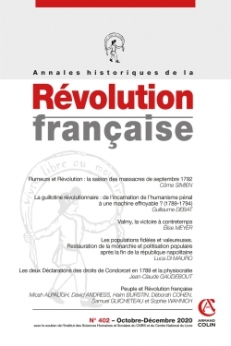
Annales historiques de la Révolution française Nº402 (4/2020)
Pour acheter ce numéro, contactez-nous
Recevez les numéros de l'année en cours et accédez à l'intégralité des articles en ligne.
Cet article entend interroger la constitution de la légende noire de la guillotine et, tout particulièrement, la place importante accordée au tournant thermidorien. Par une comparaison entre les représentations et les émotions face à la guillotine à Paris et dans certains espaces provinciaux, l’article souligne l’existence d’une gêne face à la machine à décapiter. Cette gêne est perceptible dès les premiers mois de l’exercice de la guillotine. Elle trahit la volonté des autorités de maintenir l’ordre. La peur de la guillotine est avant tout une peur sociale, celle que la foule des spectateurs des exécutions ne devienne féroce à trop contempler la machine. Si cette dernière est facilement identifiable à la « terreur » au cours de la réaction thermidorienne, c’est qu’existaient une sensibilité et une peur pré-thermidoriennes qui constituèrent le terreau favorable à la constitution de la légende noire de la guillotine.
This article examines the construction of the « Black Legend » of the guillotine and, particularly, the important place it occupied in the Thermidorian period. By comparing the depictions and emotions produced by the guillotine in Paris and in certain provincial regions, the article underscores thewidespread malaise in the face of this decapitating machine. This unease was perceptible from the first months of the guillotine’s operation. It reveals the authorities’ aim to maintain order. The fear of the guillotine was above all a social fear, a fear that the public spectacle of violence would itself induce violence in the crowd. If the image of the guillotine was readily identified with the « Terror » during the Thermidorian Reaction, it was because of the sensibility and fear that already predated Thermidor, which favored the later development of the « Black Legend » of the guillotine.

